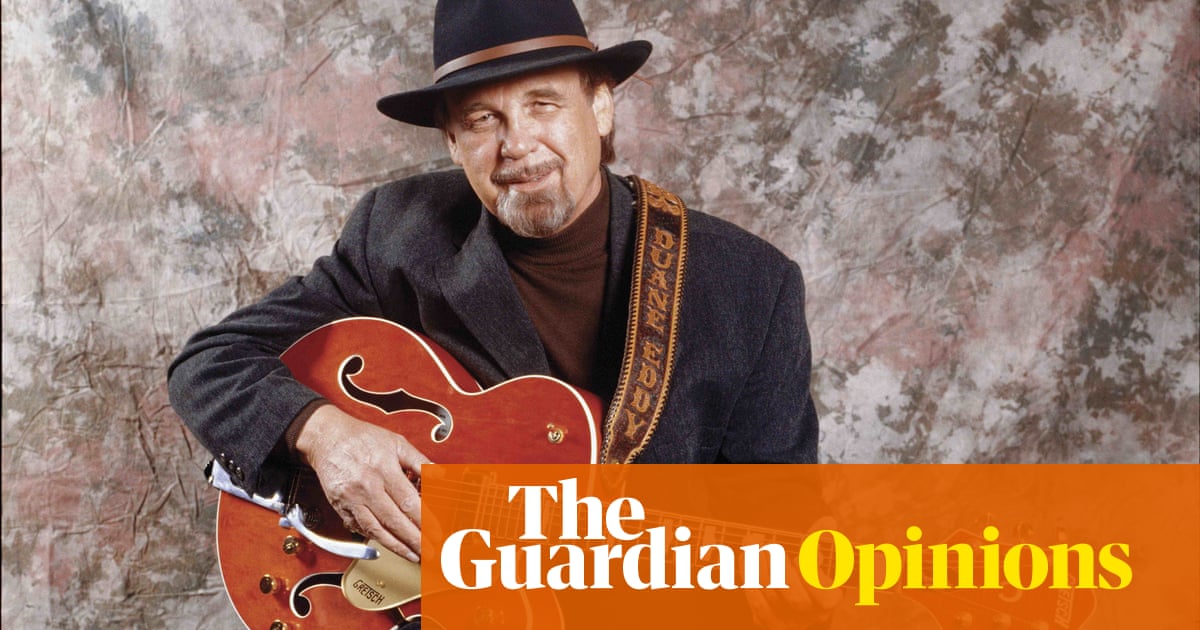
You could get the measure of Duane Eddy – who has died aged 86 – from a selection of his album titles: Have “Twangy” Guitar Will Travel (1958, his debut), The “Twangs” the “Thang” (1959), $1,000,000.00 Worth of Twang (1960, with Volume 2 in 1962), Twistin’ ’n’ Twangin (1962), “Twangin’” Up a Storm (1963), The Biggest Twang of All (1966). Concentrate not on the eccentric use of quotation marks, but on the twang, because that’s what Eddy did. From 1958 to 1963 his guitar sound – a decade later, Melody Maker would call him “the first real guitar superstar of the rock and roll age” – was all over the charts in both the US and UK, inspiring countless hordes, before disappearing almost completely when the Beatles transformed pop music.
Eddy’s sound was based on playing his lead lines on the bass strings of his guitar, then recording them in such a way that the echo and reverb was exaggerated. If he sounded as if he was playing inside a giant water tank, that was no accident: he was. When he started recording at Audio Recorders in Phoenix, Arizona, with Lee Hazlewood as producer and co-writer in 1957, Hazlewood put him inside a giant water tank to use as an echo chamber.
The result was a sound that took rock’n’roll guitar playing to a new and unheard place; Eddy’s playing on his Gretsch 6120 summoned the desert outside the city: vast and empty and unending. It didn’t sound like the humid, sexualised jitter of the rock’n’roll from the southern cities, but like the soundtrack to a trucker clocking up the miles in the glare, without another vehicle in sight. Yet his best records – Shazam!, Rebel Rouser, Peter Gunn, Cannonball, Ramrod and more – carried a sense of danger that rock’n’roll was starting to lose by the time of Eddy’s ascendancy. If his records were never as unhinged as, say Link Wray’s, then that made him palatable to the charts in a way Wray never was.
It’s hard to comprehend now how ubiquitous Eddy was at his peak: he was NME’s No 1 World Musical Personality in 1960, despite that being the year in which he tried to capitalise on the booming folk scene by releasing the frankly peculiar Songs of Our Heritage, an album of American folk standards, largely played on banjo and acoustic guitar, and entirely devoid of the twang). And when ubiquity disappeared, he did what so many other fading rock’n’roll stars did, and chased the times. In Eddy’s case that came with the 1965 album Duane Eddy Does Bob Dylan, a remarkable period piece in which Eddy’s guitar sits uncomfortably on top of folk-rock arrangements (and which also features two Hazlewood songs, and – its highlight – an extraordinary version of PF Sloan’s Eve of Destruction).
After 1967, Eddy stopped making albums to concentrate on production and session playing, though he made occasional singles – Play Me Like You Play Your Guitar was a No 9 hit in the UK in 1975. Instead he fell on the straitened times of the itinerant rock’n’roller – backed by locally recruited pick-up bands when he toured (“His act was more a public rehearsal than a polished performance,” said the NME of a 1978 gig in Margate), but the Eddy legend lived on.
You could hear it in any artist who had fallen in love with the first wave of rock’n’roll, especially in Bruce Springsteen – the scraping, twangy guitar lines in both Born to Run and Thunder Road are explicitly indebted to Eddy. You could see it when, in 1983, Eddy played a residency in Los Angeles, and Lindsey Buckingham, Eric Clapton and Tom Petty were among those who came to see him. British radio listeners would know it from John Peel, who would bang on about Eddy at any opportunity: he once played a record by a New Zealand group called the Great Unwashed specifically because it was called Duane Eddy.
Eddy’s restoration arrived from an unlikely source: British electronic group Art of Noise, who collaborated with him on a rerecording of Peter Gunn – the old Henry Mancini detective theme Eddy had covered in 1959. Eddy’s unyielding guitar line was interspersed with cut-up voices, synthesisers, blasts of horn and assorted samples. Suddenly, Eddy was back in the UK Top 10, at No 2 in the Billboard dance charts, and a Grammy winner for best rock instrumental. While there was no dramatic commercial revival as a consequence, Eddy did go back to the studio for his first new album in 20 years, and the recognition continued: in 1994 he was, rightly, inducted into the Rock and Roll Hall of Fame. Younger musicians, too, venerated him as a touchstone – the Black Keys’ Dan Auerbach employed him to bring the twang to Livin’ in Sin on his 2017 solo album Waiting on a Song.
Proof that it was not all studio trickery came when Auerbach played a one-off show at the Station Tavern in Nashville. There, stage left, white-haired and dressed in black, was a bespectacled, distinguished elderly gentlemen, with a huge Gretsch, picking out sympathetic colouring to King of a One Horse Town. The twang was still very much the thang, and it always will be.
https://news.google.com/rss/articles/CBMibGh0dHBzOi8vd3d3LnRoZWd1YXJkaWFuLmNvbS9tdXNpYy9hcnRpY2xlLzIwMjQvbWF5LzAyL2R1YW5lLWVkZHktZ3VpdGFyaXN0LXR3YW5nLXJvY2stbi1yb2xsLWdyZWF0ZXN0LXNvdW5kc9IBbGh0dHBzOi8vYW1wLnRoZWd1YXJkaWFuLmNvbS9tdXNpYy9hcnRpY2xlLzIwMjQvbWF5LzAyL2R1YW5lLWVkZHktZ3VpdGFyaXN0LXR3YW5nLXJvY2stbi1yb2xsLWdyZWF0ZXN0LXNvdW5kcw?oc=5
2024-05-02 09:44:00Z
CBMibGh0dHBzOi8vd3d3LnRoZWd1YXJkaWFuLmNvbS9tdXNpYy9hcnRpY2xlLzIwMjQvbWF5LzAyL2R1YW5lLWVkZHktZ3VpdGFyaXN0LXR3YW5nLXJvY2stbi1yb2xsLWdyZWF0ZXN0LXNvdW5kc9IBbGh0dHBzOi8vYW1wLnRoZWd1YXJkaWFuLmNvbS9tdXNpYy9hcnRpY2xlLzIwMjQvbWF5LzAyL2R1YW5lLWVkZHktZ3VpdGFyaXN0LXR3YW5nLXJvY2stbi1yb2xsLWdyZWF0ZXN0LXNvdW5kcw
Tidak ada komentar:
Posting Komentar